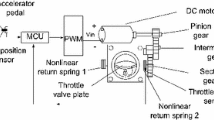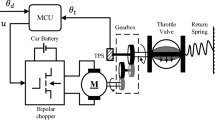Abstract
In this paper, an adaptive second-order sliding mode control approach is proposed for the performance improvement of electronic throttles (ET). Based on the traditional twisting approach, a novel adaptation mechanism based on the online zero-crossing checking is contained in the modified approach to make the control magnitude of the controller at the minimum admissible level. The idea behind it is to calculate the number of zero-crossings of the sliding surface in real time. The guaranteed stability condition and convergence region of the system are also deduced. In order to further prove its high adaptation capability, the commonly used adaptation mechanism called the Lyapunov-based type is also introduced for comparative study. Simulations and experiments validate the proposed approach with the advantages of chattering elimination, high speed and accuracy in the control of ET systems.
Similar content being viewed by others
References
J. Q. Xue and X. H. Jiao, “Speed cascade adaptive control for hybrid electric vehicle using electronic throttle control during car-following process,” ISA Transactions, vol. 110, pp. 328–343, April 2021.
Y. Li, “An extended continuum model in corporating the electronic throttle dynamics for traffic flow,” Nonlinear Dynamics, no. 4, pp. 1923–1931, 2018.
Y. H. Hu, W. Hai, and S. P. He, “Adaptive tracking control of an electronic throttle valve based on recursive terminal sliding mode,” IEEE Transactions on Vehicular Technology, vol. 10, no. 1, pp. 251–262, 2021.
B. Rui, Y. Yang, and W. J. Wang, “Nonlinear backstepping tracking control for a vehicular electronic throttle with input saturation and external external disturbance,” IEEE Access, vol. 6, no. 2, pp. 10878–10885, 2018.
A. Abdurrakhman, T. Soehartanto, and H. S. Hadi, “Design of output power control systems based on mass flow rate comparison of air-fuel ratio (AFR) on dual fuel generator set by using the PID control method,” International Journal of Technology, vol. 3, no. 11, pp. 574–586, 2020.
A. Izadbakhsh and S. Khorashadizadeh, “Polynomial-based robust adaptive impedance control of electrically driven robots,” Robotica, vol. 7, no. 39, pp. 1–21, 2020.
A. Izadbakhsh, I. Zamani, and S. Khorashadizadeh, “Szász-Mirakyan-based adaptive controller design for chaotic synchronization,” International Journal of Robust and Nonlinear Control, vol. 31, no. 5, pp. 1689–1703, 2020.
H. Rong, Q. Xu, L. Wang, C. Teng, B. Gao, J. Wang, and A Luo, “Modulated model predictive control for reliability improvement of extremely low frequency power amplifier via junction temperature swing reduction,” IIEEE Transactions on Industrial Electronics, vol. 69, no. 1, pp. 302–313, 2022.
Y. Mi, H. Zhang, Y. Fu, C. Qang, P. C. Loh, and P. Wang, “Intelligent power sharing of DC isolated microgrid based on fuzzy sliding mode droop control,” IEEE Transactions on Smart Grid, vol. 10, no 3, pp. 2396–2406, 2019.
L. Paula, D. Henrique, and E. Fortaleza, “Continuous sliding control applied to subsea oil and gas separation,” Journal of the Brazilian Society of Mechanical Sciences and Engineering, vol. 41, no. 1, pp. 42–51, 2019.
M. Reichhartinger and M. Horn, “Application of higher order sliding-mode concepts to a throttle actuator for gasoline engines,” IEEE Transactions on Industrial Electronics, vol. 56, no. 9, pp. 3322–3329, 2009.
B. Rui, “Adaptive sliding-mode control of an automotive electronic throttle in the presence of input saturation constraint,” IEEE/CAA Journal of Automática Sinica, vol. 5, no. 4, pp. 878–884, 2018.
H. Wang, Z. Li, X. Jin, Y. Huang, H. Kong, M. Yu, Z. Ping, and Z. Sun, “Adaptive integral terminal sliding mode control for automobile electronic throttle via an uncertainty observer and experimental validation,” IEEE Transactions on Vehicular Technology, vol. 67, no. 8, pp. 8129–8134, 2018.
M. Jin, J. Lee, and K. K. Ahn, “Continuous nonsingular terminal sliding mode control of shape memory alloy actuators using time delay estimation,” IEEE/ASME Transactions on Mechatronics, vol. 20, no. 2, pp. 899–909, 2015.
J. Wan, “Nonlinear control of electronic throttle based on backstepping approach,” American Journal of Electromagnetics and Applications, vol. 1, no. 4, pp. 36–41, 2016.
G. Bartolini, A. Ferrara, and E. Usai, “Chattering avoidance by second-order sliding mode control,” IEEE Transactions on Automatic Control, no. 2, pp. 241–246, 1998.
R. Qarab and I. B. Aamer, “Estimation of gasoline-engine parameters using higher order sliding mode,” IEEE Transactions on Industrial Electronics, vol. 11, pp. 3891–2898, 2008.
Y. Li and D. J. Singh, “Tunability of electronic and optical properties of the ba-zr-s system via dimensional reduction,” The European Physical Journal B, vol. 8, pp. 188–195, 2018.
H. K. Kwan, “Simple sigmoid-like activation function suitable for digital hardware implementation,” Electronics Letters, vol. 25, no. 15, pp. 1379–1385, 1992.
B. Yoo and W. Ham, “Adaptive fuzzy sliding mode control of nonlinear system,” IEEE Transactions on Fuzzy Systems, vol. 6, no. 2, pp. 354–364, 1998.
F. J. Lin and P. H. Shen, “Robust fuzzy neural network sliding-mode control for two-axis motion control system,” IEEE Transactions on Industrial Electronics, vol. 53, no. 4, pp. 1209–1225, 2006.
V. Utkin, “Discussion aspects of high-order sliding mode control,” IEEE Transactions on Automatic Control, vol. 61, no. 3, pp. 829–833, 2016.
J. Hui, “Chattering-free higher order sliding mode controller with a high-gain observer for the load following of a pressurized water reactor,” Energy, vol. 223, no. 1, pp. 102–111, 2021.
M. Mokhtari, M. Taghizadeh, and M. Mazare, “Impedance control based on optimal adaptive high order super twisting sliding mode for a 7-DOF lower limb exoskeleton,” Meccanica, vol. 1, pp. 21–27, 2021.
T. Sardarmehni and A. Heydari, “Sub-optimal scheduling in switched systems with continuous-time dynamics: A gradient descent approach,” Neurocomputing, vol. 285, pp. 10–22, 2018.
V. Paulo, L. Eduardo, and H. Liu, “Output-feedback multivariable global variable gain super-twisting algorithm,” IEEE Transactions on Automatic Control, no. 6, pp. 2999–3005, 2017.
L. Magni, R. Scattolini, and M. Tanelli, “Switched model predictive control for performance enhancement,” International Journal of Control, vol. 12, no. 81, pp. 1859–1869, 2008.
M. Corradini and G. Orlando, “Transient improvement of variable structure controlled systems via multi-model switching control,” Journal of Dynamic Systems, Measurement and Control, vol. 124, no. 2, pp. 321–326, 2002.
H. M. Wang, X. L. Ge, and C. Liu, “Second-order sliding-mode MRAS observer-based sensor less vector control of linear induction motor drives for medium-low speed maglev applications,” IEEE Transactions on Industrial Electronics, vol. 65, no. 12, pp. 9938–9952, 2018.
Y. B. Shtessel, J. A. Moreno, and L. M. Fridman, “Twisting sliding mode control with adaptation: Lyapunov design, methodology and application,” Automatica, vol. 75, no. 5, pp. 229–225, 2017.
A. Pisano, M. Tanelli, and A. Ferrara, “Time-based switched sliding mode control for yaw rate regulation in two-wheeled vehicles,” Proc. of 51st IEEE Conference on Decision and Control, Maui, USA, pp. 5028–5033, 2012.
C. Evangelista, P. Pisano, P. Puleston, and E. Usai, “Time-based adaptive second order sliding mode controller for wind energy conversion optimization,” Proc. of 53st IEEE Conference on Decision and Control, pp. 1212–1218, 2014.
A. Pisano, M. Tanelli, and A. Ferrara, “Combined switched/time-based adaptation in second order sliding mode control,” Proc. of 52nd IEEE Conference on Decision and Control, Florence, Italy, 10–13, pp. 4272–4277, December 2013.
G. Bartolini, A. Levant, A. Pisano, and E. Usai, “Adaptive second-order sliding mode control with uncertainty compensation,” International Journal of Control, vol. 89, no. 9, pp. 1747–1758, 2016.
A. Levant, “Principles of 2-sliding mode design,” Automatica, vol. 43, no. 4, pp. 576–586, 2007.
Y. H. Hu and H. Wang, “Robust tracking control for vehicle electronic throttle using adaptive dynamic sliding mode and extended state observer,” Mechanical Systems and Signal Processing, vol. 135, pp. 106375, 2020.
T. Bailing, L. Yin, and H. Wang, “Finite-time reentry attitude control based on adaptive multivariable disturbance compensation,” IEEE Transactions on Industrial Electronics, vol. 62, no. 9, pp. 5889–5898, 2015.
H. K. Khalil, Nonlinear Systems, 3rd ed., Prentice Hall, 2002.
A. Levant, “Higher-order sliding modes, differentiation and output feedback control,” International Journal of Control, vol. 76, no. 9–10, pp. 924–941, 2003.
Author information
Authors and Affiliations
Corresponding author
Additional information
Publisher’s Note Springer Nature remains neutral with regard to jurisdictional claims in published maps and institutional affiliations.
This work was partially supported by the National Natural Science Foundation of China under Grants 51879056.
Yun Long received his M.D. degree from Harbin Engineering University in 2020. He is now pursuing a Ph.D. degree from the College of Energy and Power Engineering of Harbin Engineering University, Harbin, China. His research interests include engine actuator control, sliding mode control theory, and nonlinear system control.
Yan-Min Wang received her B.Eng., M. Eng., and Ph.D. degrees from the School of Electrical Engineering and Automation, Harbin Institute of Technology (HIT), Harbin, China, in 2002, 2005, and 2009, respectively. Since 2010, she has been working in the School of Electrical Engineering and Automation, Harbin, China. And she is an Associate Professor. Her research areas include sliding mode control and intelligent control.
Chong Yao received his Ph.D. degree in marine engineering from Harbin Engineering University, Harbin, China, in 2012. He is currently an associate professor in the College of Energy and Power Engineering of Harbin Engineering University. He currently works in electronic control technology for diesel and intelligent control.
En-Zhe Song received his Ph.D. degree from Harbin Engineering University, Harbin, China, in June 2006. He is currently a professor at Harbin Engineering University. The main research areas are diesel electronically controlled fuel injection technology, electronic speed control technology, and engine intelligent control.
Quan Dong received his Ph.D. degree in power machinery and engineering from Dalian University of Technology in October 2012. He is currently an associate professor in the College of Energy and Power Engineering of Harbin Engineering University. Now he is mainly engaged in the research of engine spray atomization, gas injection and control, and emission control.
Rights and permissions
About this article
Cite this article
Long, Y., Wang, YM., Yao, C. et al. Adaptive Second-order Sliding Mode Control of Electrical Throttles Based on Online Zero-crossing Checking. Int. J. Control Autom. Syst. 22, 489–502 (2024). https://doi.org/10.1007/s12555-021-0876-4
Received:
Revised:
Accepted:
Published:
Issue Date:
DOI: https://doi.org/10.1007/s12555-021-0876-4




